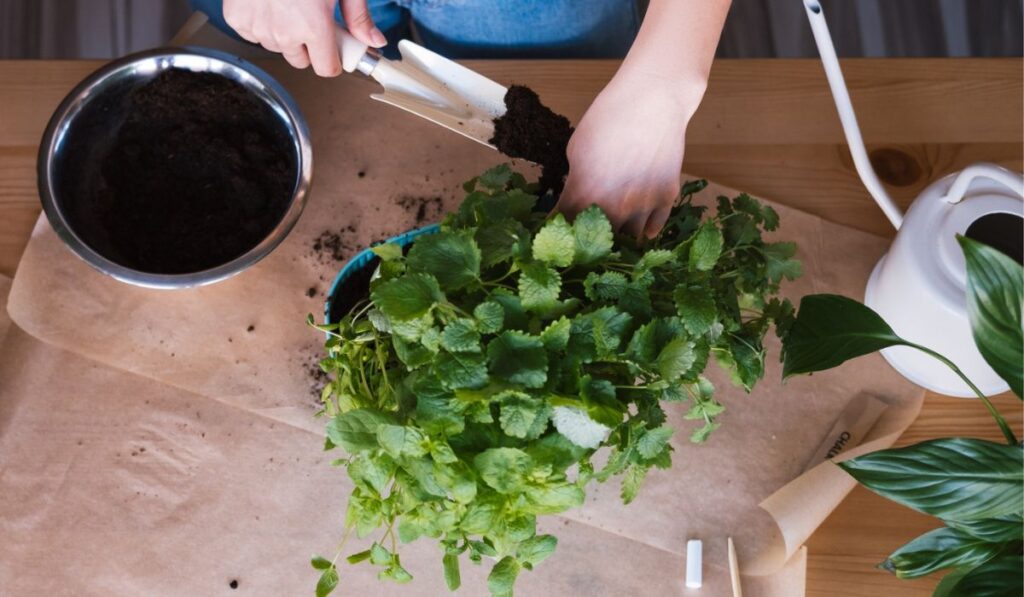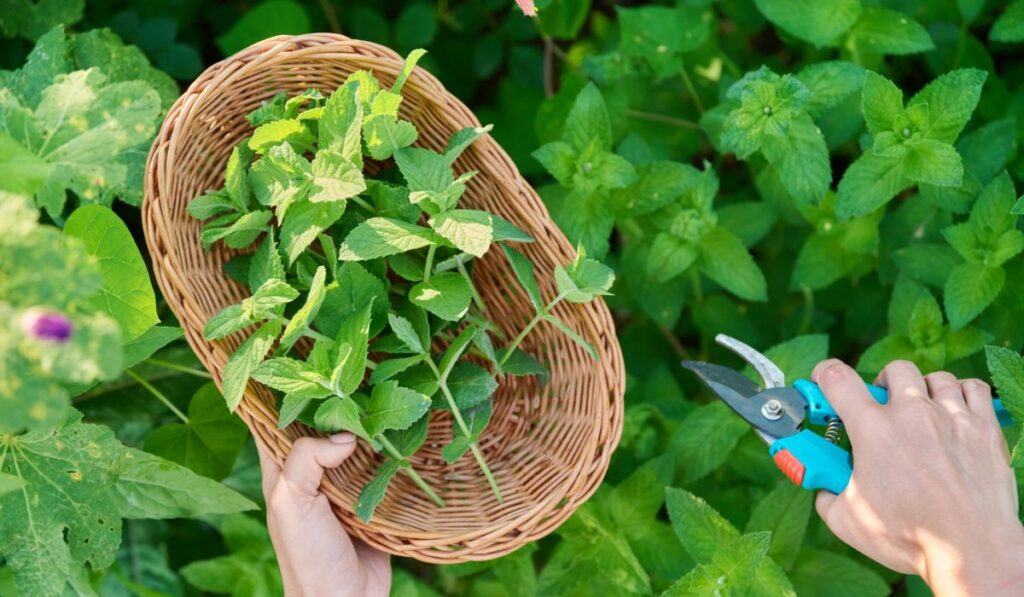From alcoholic drinks to herbal tea and cooking, mint is a versatile herb and can benefit from being in anyone’s garden. With its strong aroma and bright green foliage, mint can offer not just something to consume but also a beautiful addition to any space.
Mint is a very easy herb, but make sure you plant it in a pot as it will quickly spread throughout the garden. To harvest, pinch the stem or take up the whole plant for a larger quantity. The natural remedies it provides include relieving headaches, stress and anxiety, and upset stomachs.
Whether outdoors or on the kitchen windowsill, mint is easy to grow and can provide ample uses. And it looks pretty. So let’s dive in and learn more about growing, harvesting, and using mint!
When Should You Grow Mint?

The best time of year to plant mint (on Amazon) is in the spring. However, you can also start with seeds indoors during the winter and transplant the seedlings outside when the warmer weather comes around and the last frost has passed.
The key to planting mint is to put it in a separate pot or with a physical barrier from the rest of the garden. Mint is a fast-growing, invasive plant that will quickly take over an entire garden in a single year.
Being a hardy perennial, mint can be planted in the fall if the spring sowing season is missed. Just make sure that you plant the mint two months before the first frost, or else the shock of the colder weather could kill the seedlings.
If you prefer to have fresh leaves all year, as the plant does go dormant after the first frost, then planting it in a pot indoors might be the best option for you. Mint will continue to produce aromatic and tasteful leaves all year round. Regularly prune and harvest leaves to ensure a well-rounded and healthy growing plant.
Different Varieties of Mint
There are several popular mint varieties, all of which are fast-growing and quick-to-spread plants that quickly take over an entire garden if given a chance. Therefore, growing mint in a pot is essential to containing its prolific growth rate.
- Peppermint: Pink flowers and rounded leaves, peppermint is often used to flavor teas and scent potpourri.
- Chocolate Mint: Smelling of chocolate but tasting like orange instead, chocolate mint is often used for desserts.
- Spearmint: With pink and purple flowers, spearmint is often used in chewing gum, salads, and to flavor teas.
- Apple Mint: Light green leaves and white or pink flowers, apple mint is often used as a culinary herb with a fruity and minty taste.
- American Wild Mint: Native to North America, American wild mint is used in candies, jellies, and teas.
- Mojito Mint: Also known as Cuban mint, it’s commonly used in mojitos and has a strong aroma and flavor.
- Corsican Mint: Considered a miniature plant, Corsican mint is excellent for edging in a container with its dense leaves, fragrant aroma, and ability to withstand foot traffic like between stepping stones.
- Pineapple Mint: One of the few variegated varieties, pineapple mint is grown for its visual effect but can also be used in fruit salads, jellies, and tea.
Mint Care and Growing Tips
Mint is extremely easy to grow, and with a few tips on maintaining a healthy plant, you will be harvesting it multiple times throughout the growing season.
- Mint prefers soil pH between 6.0 and 7.0.
- Space mint plants between 18 to 24 inches apartment for optimal growth.
- Grow mint in pots as they spread fast and tend to take over gardens with their horizontal runners.
- A small plant can grow to 4 feet in just one year, so regular pruning is required.
- Keep soil moist and water when the top inch is dry.
- Regularly use water-soluble fertilizer (on Amazon) based on package instructions.
- Partial shade is the optimal sun exposure for mint; however, it can survive full sun.
Harvesting Mint

Harvesting mint is extremely easy. All you have to do is pinch off the stems for single leaves but if you need a large harvest, wait until the plant is just about to bloom before cutting the whole plant, leaving one or two sets of leaves.
This gives it the most intense flavor and allows the plant to grow again for another harvest. Typically, you can do three large harvests a season.
Storing Mint
Since mint is a prolific grower, you might not need as much as your plant produces. An excellent way to not waste your harvests is to store them. For example, freezing mint in ice cubes is a great way to add some flavor to an ice tea. You can also preserve some in vinegar to flavor dishes later or dry it out for sachets and potpourri.
Propagating Mint
The best way to propagate your mint plant is to take 6-inch cuttings from a rooted stem and plant them horizontally in the soil. Alternatively, you can place the stems in a glass of water and switch out the water every few days. Once rooted, you can transplant it into the soil.
Health Benefits of Mint
There are many culinary benefits to adding mint to your dishes since it has a unique and intense flavor that helps bring out other ingredients. However, most people don’t realize the health benefits that mint can also provide.
- Mint can offer great relief to headaches. Apply a compress of mint leaves to your forehead or rub the oils from the leaves against your temple by cutting them up or breaking the leaves to release it.
- Mint tea is a natural way to relieve stress and anxiety.
- Mint water or tea can help with indigestion and soothe an upset stomach.
- American Wild Mint is an excellent herbal remedy for tooth pain.
Conclusion
Whether planting mint for its herbal remedies, cooking benefits, or beautiful ground cover, you will soon learn that mint is very easy to grow and harvest. As a perennial, it will keep coming back, so once it’s planted, you can enjoy it for many years. Just ensure it’s contained, or your entire garden will end up as mint.
